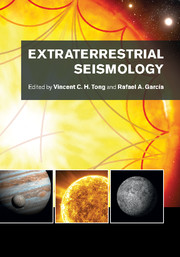Book contents
- Frontmatter
- Contents
- List of contributors
- Preface
- Acknowledgements
- List of abbreviations
- Planetary seismology: High risk, high return
- A bright outlook for helio- and asteroseismology
- Part I Observation and space missions
- Part II Data and physical parameters
- Part III Modeling approaches
- 8 Modeling approaches in asteroseismology
- 9 Modeling approaches in helioseismology
- 10 Modeling approaches in planetary seismology
- Part IV Discoveries of physical structures and processes
- Part V Interdisciplinary research involving planetary and astrophysical sciences
- Part VI Interdisciplinary research involving terrestrial seismology
- References
- Index
9 - Modeling approaches in helioseismology
from Part III - Modeling approaches
Published online by Cambridge University Press: 05 July 2015
- Frontmatter
- Contents
- List of contributors
- Preface
- Acknowledgements
- List of abbreviations
- Planetary seismology: High risk, high return
- A bright outlook for helio- and asteroseismology
- Part I Observation and space missions
- Part II Data and physical parameters
- Part III Modeling approaches
- 8 Modeling approaches in asteroseismology
- 9 Modeling approaches in helioseismology
- 10 Modeling approaches in planetary seismology
- Part IV Discoveries of physical structures and processes
- Part V Interdisciplinary research involving planetary and astrophysical sciences
- Part VI Interdisciplinary research involving terrestrial seismology
- References
- Index
Summary
Introduction
The theory of hydrodynamics or, where necessary, magneto hydrodynamics, provides an appropriate mathematical framework to study solar and stellar oscillations. Well-developed hydrodynamic descriptions of global oscillations of gravitationally bound gaseous spheres, aimed primarily at understanding stars such as Cepheid, delta-Scuti, and RR Lyrae variables, resulted from studies over half a century following that of pioneers such as Pekeris, Rosseland, and Chandrasekhar (see Ledoux and Walraven, 1958). The discovery of global non-radial oscillations on the solar surface (Leighton et al., 1962) led eventually, though not immediately, to a successful utilization of such theoretical machinery for helioseismology. It was also realized early on (Goldreich and Keeley, 1977) that the excitation of small amplitude non-radial oscillations on the Sun is due to a mechanism different from that responsible for the typically large amplitude oscillations exhibited by the above variable stars (known as the classical variables), even though both these types of oscillations are acoustic in nature. Observed solar oscillations are now recognized as mainly due to acoustic waves generated by turbulent convection near the surface layers of the outer convection zone, intrinsically damped and stable, hence limited to small amplitudes and linear evolution (Goldreich et al., 1994). These properties define the solar-like oscillations. There are also internal gravity waves, which, with buoyancy supplied by perturbations in gravity as the restoring force, propagate only in the sub-adiabatic (i.e., temperature gradients smaller than that required for convection) radiative interior beneath the convection zone, where they are evanescent. The surface gravity wave lives on the solar surface propagating horizontally.
Global helioseismology
Helioseismology consists of modeling the interior propagating acoustic and gravity waves, and the surface gravity wave, as small-amplitude linearly evolving perturbations to a background model of the Sun, and determining observable quantities to accuracies better than they are measured with. This enables updating the model iteratively for the best match with observations, thereby determining the internal structure of the Sun (Christensen-Dalsgaard, 2002).
- Type
- Chapter
- Information
- Extraterrestrial Seismology , pp. 123 - 139Publisher: Cambridge University PressPrint publication year: 2015



